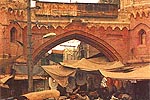A circular road around the rampart gives access to the city through thirteen gates. Some of the imposing structures of these gates are still preserved. In the bazaars of the Old City one can still come across tiny shops where craftsmen can be seen busily turning out master-pieces in copper, brass, silver and textiles in traditional fashion.
The old city has narrow colorful bazaars full of local handicrafts
and narrow winding lanes. There are many historic, cultural and
recreational places of interest in Multan. It is a commercial and
industrial center.
 Its Industries may include fertilizer, soap and glass factories, foundries; cotton, woolen and
silk textile mills; flour, sugar and oil mills; and a large
thermal-power station. It is famous for its handicrafts (ceramics
and camel-skin work) and cottage industries. There are hospitals,
public gardens, and several colleges affiliated with the University
of Punjab. The University of Multan was established in 1975. Large,
irregular suburbs have grown outside the old walled-town, apart from
this, two satellite towns have also been set up. The numerous
shrines within the old city offer impressive examples of workmanship
and architecture. These shrines are the foremost attractions for
tourists.
Its Industries may include fertilizer, soap and glass factories, foundries; cotton, woolen and
silk textile mills; flour, sugar and oil mills; and a large
thermal-power station. It is famous for its handicrafts (ceramics
and camel-skin work) and cottage industries. There are hospitals,
public gardens, and several colleges affiliated with the University
of Punjab. The University of Multan was established in 1975. Large,
irregular suburbs have grown outside the old walled-town, apart from
this, two satellite towns have also been set up. The numerous
shrines within the old city offer impressive examples of workmanship
and architecture. These shrines are the foremost attractions for
tourists.
The Shams-e-Tabriz shrine is built almost entirely of sky-blue
engravings with glazed bricks. The shrine of Shah Rukn-e Alam
(Tughlaq period) has one of the biggest domes in Asia while the
shrine of Sheikh Yusuf Gardez is considered to be a masterpiece of
the Multani style. Other shrines may include the Pahladpuri Temple
and the Idgah Mosque (1735).

Mangoes of Shujabad district are the best in the world. Multani khussa (shoes); embroidered clothes for ladies; embroidered cholas for men; earthenware pottery, painted potter, camel skinware (e.g. lamps); carpets, wooden products especially, lacquered wood furniture and ornaments are the exclusive offerings of Multan. It offers a majestic blend of Sufism and Architectural Excellence coupled with breathtaking designs and ornaments.


